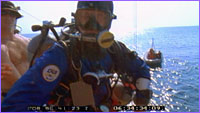
|

|
by D.J. Roller Film producer D. J. Roller takes a look at what it takes to film at a depth of 234 feet in the Atlantic Ocean, where the USS Monitor has rested since she went down in a gale on New Year's Eve, 1862. See also Saving the Monitor, by John Broadwater, manager of the Monitor National Marine Sanctuary, who leads an ongoing effort to raise and preserve key parts of the deteriorating ironclad. 0430 Alarm goes off. 0431 Find alarm behind my bunk and hit snooze. 0440 Alarm goes off again. This time I know where it is, and I hit the snooze button quicker. 0450 Alarm goes off for the third time, and my brain finally triggers a thought: "Must get up, must get coffee." 0500 Head for a quick breakfast (and coffee) to the galley, where I find director Kirk Wolfinger. No matter what, he is always the first one up in the morning. 0520 Make my way to the stern of the Kellie Chouest, the ship we're on, to prep my dive gear. [The Kellie Chouest is a civilian research and salvage ship that serves as a Navy support vessel.] This consists of setting up tanks and regulators, and checking that everything is working properly. I then verify that all cylinders have the correct gas mixture. On this expedition, we're diving a custom breathing mix called Trimix 18/50, which consists of 18 percent oxygen, 50 percent helium, and 32 percent nitrogen. Each diver is responsible for verifying that his own cylinders have the proper mix. 0550 Back inside, in a storage area we've converted into a camera room, I meet up with assistant cameraman Mike Filosa, who is prepping the topside film camera for the day. I begin prepping the underwater video camera and housing.
Walk out on deck to meet with Commander Chris Murray, master diver "Donny" Denis, my co-producer Jonathan Wickham, and Kirk to talk about the Navy's planned dive ops for the day. This is usually when we decide which dive we want to try and film that day. Since the depth of the USS Monitor is over 230 feet, our two-person film team is limited to one 30-to-40-minute filming dive a day. With a team of about 30, the Navy, on the other hand, will make about five two-man dives, weather-permitting. So we have to try and pick the best one to cover. 0645 Finish prepping underwater housing and camera and "pull a vacuum." This procedure is done with a special pump, which pulls air out of the housing to check for leaks before the camera goes in the water. 0700 Go back on deck with the topside film camera and shoot a sequence of the Navy's morning dive ops on deck. 1000 Head up to the conference room for an interior interview with expedition historian Jeff Johnston (see Tour the Monitor) and shoot b-roll of Monitor models. This turns out to be especially frustrating today. Heavy seas are making the ship vibrate like a pickup truck on a bumpy dirt road. With the ship slamming into the trough of each oncoming wave, it's virtually impossible to keep the camera stable even on the tripod. 1130 Lunch. The meals are always superb on the ship. Cliff, the chef, is Cajun, and every meal definitely sticks to the ribs. 1200 Go out on deck to discuss the filming dive plan for the day. The Diving Safety Officer today is Terrence Tysall of the Cambrian Foundation, which is dedicated to marine research and preservation. Before each dive, we have a safety briefing and dive planning meeting with the whole SCUBA team. The plan for today's dive is to film the Navy attaching a nylon lifting rig—a set of three heavy-duty nylon lines configured in a triangle format for stability—to the Monitor's propeller shaft.
Suit up for the dive and go through final checks. 1330 We splash in unison with the Navy, planning to rendezvous on the bottom. My lighting diver and dive buddy on this dive is John Chluski. Once in the water we do in-water safety checks, and then with an O.K. signal to each other we start heading down the descent line. Usually it takes between four and six minutes to reach the bottom, but today a strong current makes the going slower. 1336 As John and I approach the bottom, we realize the current is rapidly getting stronger. Once we reach bottom at 234 feet and start heading toward the wreck, we notice the exhaust bubbles coming from our regulators are going sideways instead of up. Luckily I have the camera housing clipped into me on a tether to keep it from being swept away. The visibility is continuing to drop at a noticeable rate. Today we seem to be right at the spot where the dense, green Labrador current mixes with the blue, usually clearer Gulf Stream waters. It's one of the defining characteristics of the Cape Hatteras area. Conditions can change at moment's notice, which for a diver means you can suddenly find yourself in "a very interesting situation." 1340 We move ahead slowly in the current. We're headed toward the rendezvous point with the Navy divers at the Monitor's propeller shaft. Visibility is now down to only four to five feet, and it has become very dark. Up ahead we make out the glow of one of the Navy divers' helmet lights.
We find the Navy divers struggling as well in what is now a ripping current. It's kind of comic at first. We look at one another with the same diver body language, which says "I can't believe you guys made it down here, too. This current is outrageous." Everyone goes to work, but it's slow going with the current. Then I notice that everyone is performing his allotted task one-handed, because his other hand is clenched in a Vulcan death grip on something stable, to keep him from being swept off the wreck by the current. 1358 As conditions continue to worsen, we all decide to abort the dive. It's really getting hairy. John and I rise toward our first decompression stop at 110 feet on the ascent line. (The ascent and descent lines are one and the same; it just depends on whether you're heading up or down.) The Navy divers head to an elevator platform that they will ride slowly to the surface, where they will complete most of their decompression in an onboard chamber. 1400 When we reach our first decompression stop, I can feel my fingers starting to stretch like I'm hanging from a pull-up bar. We realize that the current is way too strong to finish our two hours of decompression on the ascent line. So like skydivers leaving a plane, we give each other a three-two-one count and release ourselves into the current. Actually, we probably look more like leaves being ripped from a tree in a storm.
Maintaining our depth, John pops a lift bag to the surface while I pay out line on the reel attached to it. When it arrives at the surface, it will notify the safety divers and surface chase boat that we have left the main line and will drift in the water column for the rest of our decompression. 1625 When we surface, we're told the current has carried us almost four miles from the main ship. We pass all the equipment up into the inflatable and climb in and start heading back to the Kellie Chouest, a small orange dot on the horizon. The seas have laid down, so we make pretty good time on the way back. 1730 Back on board the Kellie Chouest, we go through the post-dive debriefing with the dive team, discussing conditions on the bottom. Then we break down the dive gear. 1800 Dinner. It is especially good tonight. Chef Cliff has prepared shrimp étouffée, a Cajun stew served over rice. Unless you're on a cruise ship, you usually don't eat this well at sea. 1900 Go back on deck to film another Navy dive team attempting to head over the side for another dive. 2000 In the camera room, John and I clean and break down the underwater camera, housing, and lights for the day. We take a moment to screen some of the dive footage; we see the Navy divers' bubbles also moving sideways in the current. 2130 We shoot an interview with project leader John Broadwater in his cabin, who talks about what lies ahead for the expedition. 2245 Break down film camera package and prep for tomorrow. 2330 Sleep Next Day 0430 Alarm goes off again and I hit snooze... Photos: (6) Courtesy of Mark Carroll. Tour the Monitor | Behind the Scenes Eyewitness to the Battle | Steam Machine | Resources Transcript | Site Map | Lincoln's Secret Weapon Home Editor's Picks | Previous Sites | Join Us/E-mail | TV/Web Schedule | About NOVA Watch NOVAs online | Teachers | Site Map | Shop | Search | To Print PBS Online | NOVA Online | WGBH © | Updated May 2003 |





